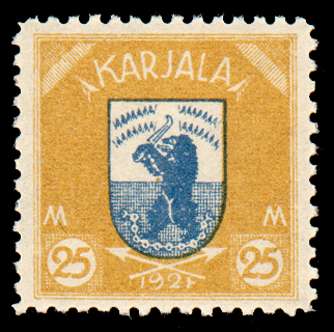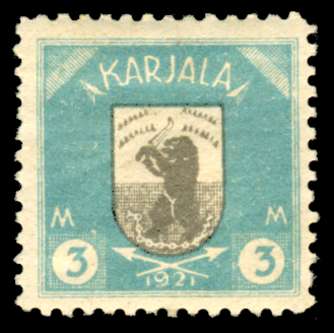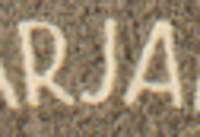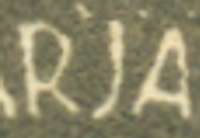|
  |
|
|
Karelia 1922 Stamp Issue
Genuine (left) and forgery (right). |
|
|
|
| Karelia: 1922 Forgeries and Genuine Stamps |
|
by Jay Smith
Background
This stamp issue was designed by architect Wäinö Gustav Pamqvist, incorportating the national coat of arms of the independent state of Karelia. The coat of arms was designed by the famous Finnish artist Akseli Gallen-Kallela. The coat of arms pictures a bear which has broken his chain shakles and is storming into battle, armed with a billhook, under the northern lights.
Karelia Forgeries General Information
In my experience, the majority of the 1922 stamps offered in the marketplace by collectors or non-specialist dealers are forgeries. This is even sometimes true when offered by well-known, respected, non-specialist dealers; they are not trying to fool anybody -- they simply don't know how to separate the genuine from the forgeries and they have not had them examined by an expert. In my experience, the vast majority of those offered at Internet auction are forgeries, and, not surprisingly, it is usually not possible to see in the Internet auction image the detail necessary to make the determination.
The forgeries of this issue are very good and will deceive virtually all people who do not have the necessary identification information. I have observed only one type of forgery circulating, however, they have been around a very long time and are found even in "very old" collections. The Finland Reference Manual of Forgeries (though Release 8, which is the most recently issued at this writing) only lists one forgery type as well. The Manual says "The forger is probably N. Imperato of Genoa, Italy." Lape 2010 states "Several different forgeries of the stamps are found..." but only gives vague details of the forgery described on this web page.
The key features of this forgery are the same for all 15 denominations. The denomination numerals, which were added to the basic forgery design, do have minor differences when compared to the genuine, but other features are easier to see.
Used Stamps and Postmarks
Genuine used stamps are rare, but do exist. Forged and after-canceled postmarks on used stamps are a problem. By the time the stamps were issued on 31 January 1922, the revolt was in its last days. Lape 2010 states that the stamps are only "proven" to have been used at Uhtua from 31 January, however Uhtua was lost to the Russians as early as 6 February, with the last known certain postmarks dated 3 February (the most common date seen), though a few dated 4 and 5 February are known. The post office then moved to Suomussalmi (in Finland) where the stamps were apparently used through 16 February -- though Suomussalmi uses are sometimes questioned. Cancellations dated 17 February 1922 or after cannot be legitimate. Lastly, genuine stamps exist with various forged cancellations (both genuine looking and those that do not resemble genuine postmarks) and stamp forgeries also exist with forged cancellations.
Perforation Differences in the Genuine Stamps
One aspect that confuses the subject is that the non-specialized catalogs do not mention that there are perforation differences among the 15 genuine stamps. Five stamps exist in both perforation 11.25 and perforation 11.75. Furthermore, the other denominations exist in one or the other of the perforations shown with an "X" in the following table. Because this small perforation difference can be hard to discern using some perforation gauges, it is easiest to use the table below to determine which stamps exist with only perforation 11.25 or 11.75 and then use one of those (genuine) stamps as a gauge to measure your other stamps (position the stamps perf tips to perf tips on a flat surface).
| Karelia 1922 Perforations -- Genuine Stamps |
| Denomination |
Perf 11.25 |
Perf 11.75 |
| # 1 -- 5 p |
X (scarcer) |
X |
| # 2 -- 10 p |
X |
|
| # 3 -- 20 p |
|
X |
| # 4 -- 25 p |
X (scarcer) |
X |
| # 5 -- 40 p |
X |
|
| # 6 -- 50 p |
|
X |
| # 7 -- 75 p |
X |
|
| # 8 -- 1 m |
|
X |
| # 9 -- 2 m |
X (scarcer) |
X |
| # 10 -- 3 m |
X |
|
| # 11 -- 5 m |
|
X |
| # 12 -- 10 m |
X |
X (scarcer) |
| # 13 -- 15 m |
|
X |
| # 14 -- 20 m |
X |
|
| # 15 -- 25 m |
X (scarcer) |
X |
Distinguishing the Forgeries
Both the genuine stamps and the forgeries vary in the quality of the printing impression and the inking, thus some points of identification are more reliable than others. However, one single feature is usually the key to identification: The shape of the "J" in "KARJALA". One should not rely on this alone, however, it is the first feature to check. Then the gum should be examined, followed by the ink color and the paper brightness. However, usually a collector has only genuine or forged stamps available to examine thus comparisons of the gum, ink, and paper are not as useful. (However, note that it is not uncommon for a full set of contain a mix of genuine and forged stamps -- the set may have been built a stamp at a time from multiple sources.)
One should not be particularly suspicious of never hinged stamps. At least up until 1995, there was a stock of never hinged stamps still being broken up. However, it is rare to find never hinged examples of the forgeries.
| Karelia 1922 Genuine vs Forgery Comparison |
| Feaure |
Genuine |
Forgery |
| Shape of "J" in "KARJALA" |
The bottom of the J curves back up; pointing above the leg of the R and pointing to an imaginary 10 o'clock position.
 |
The bottom of the J does not curve back up; pointing below the leg of the R and pointing to an imaginary 7 or 8 o'clock position. Sometimes barely starts to point back up, but the base is shorter than the genuine.
 |
| Northern Lights above Bear |
Well formed, usually without gaps in the lines of points. |
Usually poorly formed, either with indistinct points and/or many gaps in the lines of points. |
| Design Details |
Generally clearer and neater. |
Generally less clear, often filled-in, missing detail. |
| Shape of Lettering |
Lettering strong and clear, well formed. "R" with nicely rounded top. Final "A" bold, even, with square ends. |
Lettering often weak and poorly formed. The "R" usually angular with dent in top. The final "A" usually weak and irregular. |
| Perforations |
Variously perforated 11.25 and/or 11.75. See table above. |
The examples I have examined are perforated 11.25. |
| Gum |
Old looking, often with a crackly or checkerboard appearance. Darker (yellower) appearance. No gum examples are seldom seen. |
New looking, usually smooth and even. Whiter apperance. No gum examples are frequently seen. |
| Ink Color |
Slightly muted colors. |
Brighter, usually more intense colors. The colors are a remarkably good match, but when compared, the differences are clear. |
| Printing Surface |
The ink coverage is usually slightly mottled or grainy appearing. |
The ink coverage is smoother and cleaner looking. |
| Paper Color |
The paper is slightly yellowish and of medium thickness. |
The paper is usually whiter (though often examples have been yellowed with age) and thinner. |
| Paper Size |
"Sensible looking" margins. |
Often (perhaps 60% of the time) larger paper size resulting in one or more broader margins. |
| Centering |
Less variability in centering. Though centering can vary from VF to Average, it is usually F-VF or VF. |
Greater variability in centering. It's not unusual for the perforations to cut or just clear the design. |
|

